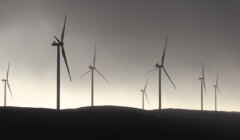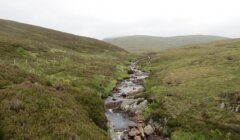Energy / ‘Unprecedented’ lack of trout in Burn of Lunklet following wind farm construction
Viking Energy said the position related to Burn of Lunklet ‘needs to be set in overall context’
CONCERN has been raised after a new report suggested there may no longer be any trout in the Burn of Lunklet following the construction of the Viking Energy wind farm.
The fish monitoring report, by Waterside Ecology on behalf of Viking Energy, also said remedial action was “urgently required” at a nearby wind farm borrow pit to curtail pollution in the burn, which has been “substantially impacted by very low pH and high concentrations of a number of metals”.
It said the lack of trout in an August survey was “unprecedented”, as previous data from as far back as 2008 showed fish being present.
The report said the trout appearing to be absent from the Burn of Lunklet – a Site of Special Scientific Interest (SSSI) – was likely to be a result of changes to water and habitat quality.
But a spokesperson for Viking Energy said the position needs to be set in overall context – with 33 out of 34 sites surveyed in and around the wind farm site showing trout.
They added that trout is still present in “relative abundance” in the lochs and burns which adjoin the upper reaches of the Burn of Lunklet.
Last year mitigation work was undertaken after an increase in metals/minerals was recorded in water in the Burn of Lunklet during the Viking Energy wind farm construction. The Scottish Environment Protection Agency (SEPA) was informed.
The latest fish monitoring report said: “The data clearly indicate that by August 2022, when the fish surveys took place, conditions in Burn of Lunklet were unsuited to trout.
“This lack of trout is unprecedented as data show that trout were present at all sites previously sampled in this stream (Waterside Ecology 2008, 2020, 2021).
“A single trout parr was found downstream of the confluence of Burn of Marrofied Water.
Become a member of Shetland News
“This latter result suggests that water quality remains very poor downstream of the confluence, despite the ameliorating effects of dilution via flows from Burn of Marrofield-water and Burn of Lambawater.”
Moraig Lyall, who chairs the council committee on the environment and transport, also raised the issue at a meeting about net zero in Lerwick on Wednesday night.
She questioned whether the “construction of wind farms is fundamentally at odds with our commitment to preserve and enhance biodiversity”.
Lyall added in response to the fish report: “What this report appears to show is that the fears that many people had about the impact of the the construction of VEWF [Viking Energy Wind Farm] on the ecology of the site have been proved to be well founded.
“It’s a travesty that a burn that has had a trout population for many years has now been rendered unsuitable for fish.
“Remedial action will have to be taken by the companies involved but sadly it’s likely unknown how effective that will be or how long it will take.
“Events like this should be kept firmly in mind by those still looking at granting permission for further developments. This gives concrete evidence of the impact that developing wind farms on peatland landscapes will have.”
Meanwhile a new water quality monitoring report has also been issued as part of planning conditions for the wind farm construction.
It confirms that borrow pit KPB02 continues to be the most likely source of low pH and “resultant mobilisation of metals”.
Sustainable Shetland chairman Frank Hay said the campaign group is “very disappointed” by the apparent impact on the trout population.
“Some of the trout in the Scallafield area may well be a unique sub-species and should have been protected,” he added.
“It remains to be seen what the long term effect on all the ecosystems in the area will be.”
Hay also said the latest water quality report on the Burn of Lunklet “comes as no surprise” to members of the group.
“This pollution issue was highlighted in many of our responses to the original planning application,” he said.
“It is especially disappointing that it should occur in the area of an SSSI.”
He said a proper survey of the main source of the pollution, the borrow pit entitled KPB02, should have highlighted that the rock there could cause issues.
“Consideration should be given to prosecuting Viking Energy for allowing this to happen – where are SEPA in all of this?”
Hay also raised concern about the aquaculture industry, “as run off from the wind farm site will eventually reach the sea”.
An update provided to a meeting of the Viking community liaison group this week said that contractor RJ McLeod has committed to “expedite the reinstatement” of the section of the borrow pit in question.
That work is expected to be completed by the end of March. The borrow pit as a whole is already around 80 per cent capped through its use as a peat storage area, but it will require formal reinstatement.
But a warning was made that the issue is not one that will be immediately solved, so “all remedial measures are not in place”. The team are now moving into a long-term mitigation strategy, group members were told.
“We remain actively committed to resolving this issue and to providing a permanent solution,” the update said.
It is expected that further “rock gaining” activity at the borrow pit will cease in the coming weeks, with one additional blast due in order to re-profile the section to make it suitable for reinstatement.
A spokesperson for Viking Energy Wind Farm said: “The position related to Burn of Lunklet, in VEWF’s December 2022 fish population monitoring report, needs to be set in overall context.
“Trout were present at 33 of the 34 survey sites, in and around the wider wind farm construction site, with their relative abundance matching that observed during baseline monitoring.
“Trout are still present in relative abundance in the lochs and burns which adjoin the upper reaches of the Burn of Lunklet.
“What has changed, is that the trout present in this localised system are choosing not to spawn in the upper reaches of the Burn of Lunklet under current conditions, but the fish remain present in other parts of the water system (burns and lochs) in the area.
“The principal recommendation of the fish population monitoring report on the Burn of Lunklet, is capping off Kergord Borrow Pit 02 (KBP02) with a thick, dense layer of peat to prevent oxidisation of minerals, as the most practical preventative measure.
“As was explained in detail at the recent Community Liaison meeting, on Tuesday (24 February) KBP02 is now in the process of being made suitable for this capping to take place and it is expected to be in place by the end of March 2023.”
Meanwhile more information about the convoys of wind farm turbine parts was given this week at the latest Viking Energy community liaison group meeting.
Convoys of parts are due to take place from Lerwick to the wind farm site in the Central Mainland between February and July, and more details about the timings can be found here.
Meeting chairman Andrew Archer asked about whether people may be able to overtake the convoys – suggesting there could be, for example, some drivers needing to catch ferries stuck in the traffic.
SSE Renewables’ wind turbine package manager Jonny Flowers said there may be times where police, who will be escorting the convoys, deem it safe for the lorries to pull over if there is a build up of traffic.
However he explained that in some instances it may be more efficient for the convoys just to head straight to site.
It is expected that the convoys will take around an hour to get from Lerwick to the wind farm site.
While the best case scenario is that the convoys will be completed before the start of July, there is an acceptance that due to outside factors like the conditions, it could slip into July itself.
Become a member of Shetland News
Shetland News is asking its many readers to consider paying for membership to get additional features and services: -
- Remove non-local ads;
- Bookmark posts to read later;
- Exclusive curated weekly newsletter;
- Hide membership messages;
- Comments open for discussion.
If you appreciate what we do and feel strongly about impartial local journalism, then please become a member of Shetland News by either making a single payment, or setting up a monthly, quarterly or yearly subscription.





































































